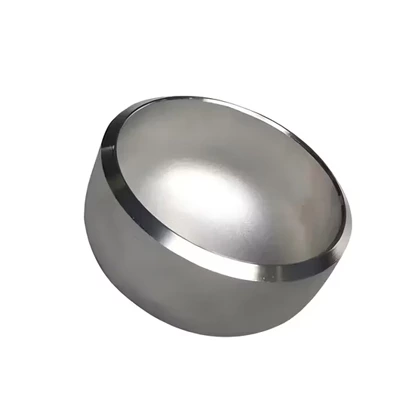How To Repair Butt Weld Pipe Caps?
Stainless steel weld caps are essential components in piping systems, widely used to seal and connect various types of pipes. They not only effectively prevent leakage and ensure safe and stable operation of the piping system, but also regulate pressure and temperature. However, over time, weld on pipe caps steel can also face a series of common problems, including material issues, welding quality issues, and dimensional and machining accuracy issues. Advances in pipeline construction and repair technology have effectively resolved many of these issues through repair or replacement. Repair methods and precautions for these common problems are crucial to ensuring the safety of piping systems. This article will analyze the repair methods and precautions for butt weld pipe cap from the perspective of common problems, and discuss the options between DIY and professional repairs. By combining real-world cases with expert advice, we hope to provide a reference for pipeline industry practitioners, helping them resolve common issues and improve repair efficiency and pipeline system stability.
Butt-weld Pipe Caps - Common Problems and Repairs
The following are some of the most common problems with stainless buttweld caps and their solutions:
Material Issues
Material issues with stainless steel buttweld caps are a common problem in pipeline repair. Common pipe cap materials include stainless steel, carbon steel, and alloy steel. However, in some special environments, these materials may not withstand the corrosive effects of the fluids or high temperatures within the pipeline, leading to cracking or failure. For example, carbon steel is susceptible to corrosion when used in highly corrosive environments, causing surface cracks. This problem is particularly prominent in oil, chemical, and seawater environments.
The choice of material is crucial for the strength and pressure resistance of the pipe cap. Certain high-temperature and high-pressure piping systems require materials such as alloy steel or nickel alloys to ensure stability in these environments. However, welding characteristics and durability vary between different materials, and the appropriate material often needs to be selected during the repair process based on the pipeline's operating environment.
Expert Zhang Ming pointed out that choosing the right pipe cap material and avoiding long-term exposure to extreme environments can significantly extend the service life of the pipeline system. Therefore, using a material that matches the original pipeline system during the repair process is particularly important. Especially for pipelines subject to high pressure and temperature, choosing the right material for the repair can effectively prevent recurrence of damage.
Welding Quality Issues
Welding quality issues are one of the most common problems encountered during pipe cap repair. Poor cap welding can lead to insufficient joint strength, which can lead to cracks or leaks. Common welding quality issues include uneven welding temperatures, incomplete welds, and improper welding procedures. These problems often occur due to improper welding procedures or equipment malfunctions. Excessively high temperatures can cause pipe cap deformation, while excessively low temperatures can lead to incomplete welds and the formation of microcracks.
Welding quality directly impacts the sealing and safety of pipeline systems. If leaks or cracks exist at the weld, pipeline contents may leak, causing pipeline failure or safety incidents. Therefore, strict welding procedures and operating standards must be adhered to during weld repairs. Before repairs are performed, thoroughly inspect the pipe cap to ensure there are no hidden dangers before proceeding with the repair.
Using high-quality welding materials and specialized equipment is also crucial during the welding repair process. Expert Li Qiang recommends using automated welding equipment to improve welding accuracy and stability, avoiding quality issues that can occur with manual operation.
Size and Processing Precision Issues
The size and processing precision of pipe caps significantly impact the effectiveness of welding and assembly. In some cases, improper size or insufficient processing precision of steel buttweld caps can prevent them from fitting perfectly into the pipe joint, compromising their sealing performance. For example, a mismatch between the inner diameter of the cap and the outer diameter of the pipe can create gaps in the weld, leading to leaks.
Furthermore, poor processing precision can lead to uneven pressure distribution during cap installation, compromising the long-term stability of the piping system. Particularly in high-pressure environments, improperly sized caps can break during use due to the inability to withstand the pressure. Therefore, when selecting and repairing pipe caps, strict requirements must be met regarding size and processing precision to ensure a tight fit with the pipe.
DIY vs Professional Repair of Butt-weld Pipe Caps – Material and Safety Issues
Material Issues: When performing DIY repairs, it is crucial to select the appropriate cap material. For most simple pipes, repairs using standard carbon steel or stainless steel caps may be feasible. However, for pipe systems subject to specialized environments, such as high-temperature, high-pressure, or highly corrosive environments, it is best to enlist professional repair services to ensure the material can withstand the operating conditions.
Safety: Safety is always the primary consideration in pipeline repair. Lack of professional knowledge and experience during DIY repairs can make repair quality difficult to guarantee, potentially leading to serious safety hazards. Therefore, when dealing with complex pipeline issues, seeking professional assistance is the best option for ensuring the safety of the pipeline system.
Conclusion
Repairing welded pipe caps is a highly technical task, involving multiple aspects such as material selection, welding techniques, and dimensional accuracy. Every detail of the repair process must be meticulously scrutinized to ensure the long-term safe operation of the pipeline system. While DIY repairs may be effective for common problems, professional assistance is recommended for pipelines exposed to high pressure, high temperature, and other challenging environments to ensure the quality and safety of the repair.
For additional welded pipe cap services and optimization tips, please visit Huahao website!
